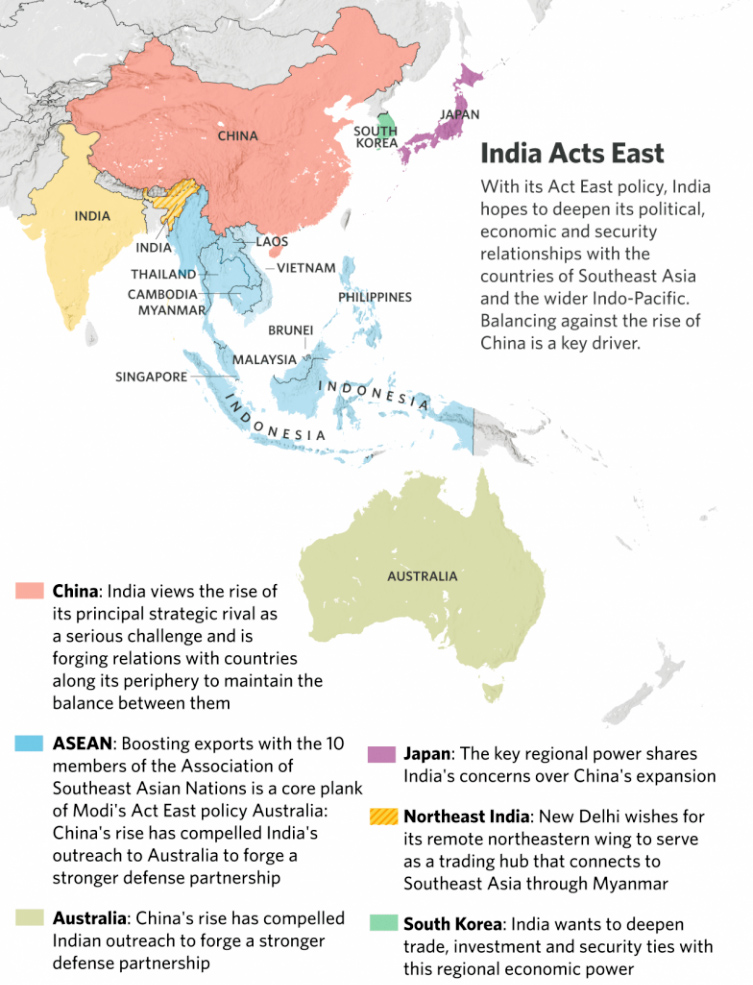International Relations
India’s Act East Policy
- 18 Mar 2021
- 5 min read
Why in News
Recently, the Union Minister of State Development of North Eastern Region (DoNER) said that connectivity is an important element of Act East Policy.
Key Points
- About:
- The ‘Act East Policy’ announced in November, 2014 is the upgrade of the “Look East Policy”.
- It is a diplomatic initiative to promote economic, strategic and cultural relations with the vast Asia-Pacific region at different levels.
- It involves intensive and continuous engagement with Southeast Asian countries in the field of connectivity, trade, culture, defence and people-to-people-contact at bilateral, regional and multilateral levels.
- Aim:
- To promote economic cooperation, cultural ties and developing a strategic relationship with countries in Indo-pacific region with a proactive and pragmatic approach and thereby improving the economic development of the North Eastern Region (NER) which is a gateway to the South East Asia Region.
Look East Policy
- In order to recover from the loss of the strategic partner -USSR (end of the Cold war 1991), India sought to build up a relationship with the USA and allies of the USA in Southeast Asia.
- In this pursuit, former Prime minister of India P V Narasimha Rao launched Look East policy in 1992, to give a strategic push to India’s engagement with the South-East Asia region, to bolster its standing as a regional power and a counterweight to the strategic influence of the People’s Republic of China.
- Difference Between Look East and Act East:
- Look East:
- Look East policy focused on the Association of Southeast Asian Nations (ASEAN) countries + Economic Integration.
- India became a dialogue partner of ASEAN in 1996 and summit level partner in 2002.
- In 2012 the relationship got up-graded into a Strategic Partnership.
- The time when India launched the Look East Policy in 1992, India's trade with ASEAN was USD 2 billion. After signing the Free Trade Agreement in 2010 with ASEAN, the trade has grown to USD 72 billion (2017-18).
- India is also an active participant in several regional forums like the East Asia Summit (EAS), ASEAN Regional Forum (ARF) etc.
- Look East policy focused on the Association of Southeast Asian Nations (ASEAN) countries + Economic Integration.
- Act East:
- Act East Policy focused on ASEAN countries + Economic Integration + East Asian countries + Security cooperation.
- Prime minister of India highlighted 4C's of Act East Policy.
- Culture
- Commerce
- Connectivity
- Capacity building
- Prime minister of India highlighted 4C's of Act East Policy.
- Security is an important dimension of India's Act East Policy.
- In the context of growing Chinese assertiveness in the South China Sea and the Indian Ocean, securing freedom of navigation and India's own role in the Indian Ocean is a key feature of Act East Policy.
- In pursuance of this, India has been engaged under the narrative of Indo-pacific and informal grouping called Quad.
- Act East Policy focused on ASEAN countries + Economic Integration + East Asian countries + Security cooperation.
- Look East:
- Initiatives to Enhance Connectivity:
- Agartala-Akhaura Rail Link between India and Bangladesh.
- Intermodal transport linkages and inland waterways through Bangladesh.
- Kaladan Multimodal Transit Transport Project and the Trilateral Highway Project connecting the North East with Myanmar and Thailand.
- Under India-Japan Act East Forum, projects such as Road and Bridges and modernization of Hydro-electric power projects have been undertaken.
- India-Japan Act East Forum was established in 2017 which aims to provide a platform for India-Japan collaboration under the rubric of India’s "Act East Policy” and Japan’s "Free and Open Indo-Pacific Strategy”.
- The Forum will identify specific projects for economic modernization of India’s North-East region including those pertaining to connectivity, developmental infrastructure, industrial linkages as well as people-to-people contacts through tourism, culture and sports-related activities.
- Other Initiatives:
- Assistance extended in the form of medicines/medical supplies to ASEAN countries during the pandemic.
- Scholarships with offers of 1000 PhD fellowships have been offered at IITs for ASEAN countries participants.
- India is also implementing Quick Impact Projects in Cambodia, Laos, Myanmar and Vietnam to provide development assistance to grass-root level communities in the fields of education, water resources, health etc.
- Quick Impact Projects (QIPs) are small-scale, low cost projects that are planned and implemented within a short timeframe.





